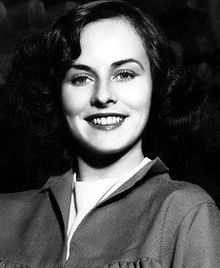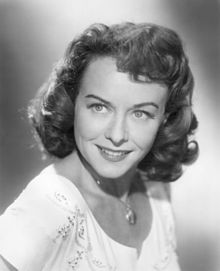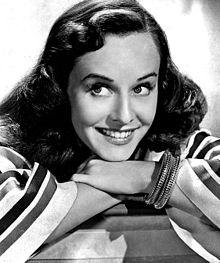Paulette Goddard
- Birth Date:
- 03.06.1910
- Death date:
- 23.04.1990
- Extra names:
- Paulette Goddard, Полетт Годдар, Pauline Marion Levy, Марион Полин Леви
- Categories:
- Actor
- Nationality:
- american
- Cemetery:
- Set cemetery
Paulette Goddard (June 3, 1910 – April 23, 1990) was an American actress. A child fashion model and a performer in several Broadway productions as a Ziegfeld Girl, she became a major star of the Paramount Studio in the 1940s. Goddard was nominated for an Academy Award for Best Supporting Actress for her performance in 1943's So Proudly We Hail! (1943).
Early life
According to biographer Julie Gilbert, Goddard was born in Whitestone Landing, Queens, New York or Great Neck, Long Island on June 3, 1910, and according to her birth certificate was named Marion Goddard Levy. However, various later documents mention different birth years and places as well as names. Legal documents and a passport listed her birth year as 1905 and 1915, and when asked to clarify the confusion over her age in a 1945 interview with Life, Goddard claimed that she was in fact born in 1915. She also later claimed in a magazine column to have been born inManhattan, and according to her second husband, Charlie Chaplin, she was born inBrooklyn. Goddard's name has also been cited as Marion Levy and Pauline Marion Levy.
Goddard was the only child of Joseph Russell Levy (d. 1954), son of a prosperous Jewish cigar manufacturer from Salt Lake City, and Alta Mae Goddard (1887–1984), who was Episcopalian and of English heritage. They had married in 1908 and separated while their daughter was very young, although the divorce did not become final until 1926. According to Goddard, her father had left them, but according to J.R. Levy, Alta had vanished with her. Goddard was raised by her mother, and did not meet her father again until in the late 1930s, when she was already famous. In a 1938 interview published in Collier's, Goddard claimed that Levy was not her biological father. In response, Levy filed a suit against his daughter, claiming that the interview had ruined his reputation and lost him his job, and demanded financial support from her. Goddard eventually won the case.
In order to avoid a custody battle, Goddard and her mother moved often during her childhood, even relocating to Canada at one point. Goddard started modelling as a preteen in order to support herself and her mother, working for Saks Fifth Avenue and Hattie Carnegie amongst others. An important figure in her childhood was her great-uncle, Charles Goddard, the owner of the American Druggists Syndicate. He played a central role in starting Goddard's career, as he introduced her to Broadway impresario Florenz Ziegfeld. In 1926, she made her stage debut as a dancer in Ziegfeld's summer review, No Foolin', which was also the first time that she used the stage name Paulette Goddard. Ziegfeld also hired her for another review, Rio Rita, which opened in February 1927, but she left the show after only three weeks to appear in the play The Unconquerable Male, produced by Archie Selwyn. It was, however, a flop and closed after only three days following its premiere in Atlantic City.
Soon after the play closed, Goddard was introduced to Edgar James, president of the Southern Lumber Company, located inAsheville, North Carolina, by Charles Goddard. Although she was only sixteen at the time and considerably younger than James, they married on 28 June 1927 in Rye, New York. It was a short marriage, and Goddard was granted a divorce in Reno, Nevada in 1930, receiving a divorce settlement of $375,000.
Film career
Goddard's first visit to Hollywood had taken place in 1929, when she had appeared as an uncredited extra in two films, the Laurel and Hardy short film Berth Marks and George Fitzmaurice's drama The Locked Door. Following her divorce, she briefly visited Europe before returning to Hollywood in late 1930 with her mother. Her second attempt to succeed as an actress was initially no more successful than the first, as she landed work only as an extra. In 1932, she signed her first film contract with producer Samuel Goldwyn to appear as a chorus girl in The Kid from Spain. Goddard and Goldwyn did not get along, and she soon started working for Hal Roach Studios, appearing in a string of uncredited supporting roles for the next four years.

![]()
Studio publicity portrait for Modern Times (1936), in which Goddard had her first substantial film role.
However, the same year as she signed with Goldwyn, Goddard also began dating film comedian Charlie Chaplin, a relationship which received a substantial amount of attention from the press. It also marked a turning point in Goddard's career when Chaplin cast her as his leading lady in his next box office hit, Modern Times, in 1936. Her role as "The Gamin", an orphan girl who runs away from the authorities and becomes The Tramp's companion, was her first credited film appearance and garnered her mainly positive reviews, Frank S. Nugent of The New York Times describing her as "the fitting recipient of the great Charlot's championship".
Following the success of Modern Times, Chaplin planned other projects with Goddard in mind as a co-star, but he worked slowly and Goddard worried that the public might forget about her if she did not continue to make regular film appearances. She signed a contract with David O. Selznick and appeared with Janet Gaynor in the comedy The Young in Heart (1938) before Selznick loaned her to MGM to appear in two films. The first of these,Dramatic School (1938), costarred Luise Rainer, but the film received mediocre reviews and failed to attract an audience.[12] Her next film, The Women (1939), was a success. With an all-female cast headed by Norma Shearer, Joan Crawford, and Rosalind Russell, the film's supporting role of Miriam Aarons was played by Goddard. Pauline Kael would later comment of Goddard, "she is a stand-out. She's fun."
![]()
Studio publicity portrait from the 1940s, when Goddard was working for Paramount Pictures.
Selznick had been pleased with Goddard's recent performances, and specifically her work in The Young at Heart, and considered her for the role of Scarlett O'Hara. Initialscreen tests convinced him and the director George Cukor that Goddard would require coaching to be effective in the role, but that she showed promise, and she was the first actress given a Technicolor screen test. Russell Birdwell, the head of Selznick's publicity department, had strong misgivings about Goddard. He warned Selznick of the "tremendous avalanche of criticism that will befall us and the picture should Paulette be given this part…
I have never known a woman, intent on a career dependent upon her popularity with the masses, to hold and live such an insane and absurd attitude towards the press and her fellow man as does Paulette Goddard… Briefly, I think she is dynamite that will explode in our very faces if she is given the part." Selznick remained interested in Goddard and after he had been introduced to Vivien Leigh, he wrote to his wife that Leigh was a "dark horse" and that his choice had "narrowed down to Paulette,Jean Arthur, Joan Bennett, and Vivien Leigh"
After a series of tests with Leigh that pleased both Selznick and Cukor, Selznick cancelled the further tests that had been scheduled for Goddard, and the part was given to Leigh. It has been suggested that Goddard lost the part because Selznick feared questions surrounding her marital status with Charlie Chaplin would result in scandal. However, Selznick was aware that Leigh and Laurence Olivier lived together as their respective spouses had refused to divorce them, and in addition to offering Leigh a contract, he engaged Olivier as the leading man in his next production Rebecca(1940). Chaplin's biographer Joyce Milton wrote that Selznick was worried about legal issues by signing her to a contract that might conflict with her preexisting contracts with the Chaplin studio.

![]()
Paulette Goddard in a publicity shot forA Stranger Came Home.
Goddard signed a contract with Paramount Pictures and her next film The Cat and the Canary (1939) with Bob Hope, was a turning point in the careers of both actors. She starred with Chaplin again in his 1940 film The Great Dictator. The couple split amicably soon afterward, and Goddard allegedly obtained a divorce in Mexico in 1942, with Chaplin agreeing to a generous settlement. She was Fred Astaire's leading lady in the musical Second Chorus (1940), where she met her third husband, actor Burgess Meredith. One of her best-remembered film appearances was in the variety musical Star Spangled Rhythm (1943), in which she sang a comic number, "A Sweater, a Sarong, and a Peekaboo Bang", with Dorothy Lamour and Veronica Lake.
She received one Oscar nomination for Best Supporting Actress, for the 1943 film So Proudly We Hail!, but did not win. Her most successful film was Kitty (1945), in which she played the title role. In The Diary of a Chambermaid (1946), she starred opposite Burgess Meredith, to whom she was married at the time. Cecil B. DeMille cast her in three blockbusters: North West Mounted Police (1940), Reap the Wild Wind (1942) (where Goddard played a Scarlett O'Hara-type role), and Unconquered (1947). Her career faded in the late 1940s.
In 1947 she made An Ideal Husband in Britain for Alexander Korda films, being accompanied on a publicity trip to Brussels by Clarissa Churchill, niece of Sir Winstonand future wife of Prime Minister Anthony Eden. In 1949, she formed Monterey Pictures with John Steinbeck. Her last starring roles were the English production A Stranger Came Home (known as The Unholy Four in the United States), and Charge of the Lancers in 1954. She also acted in summer stock and on television, including the 1955 television remake of The Women, playing the Sylvia Fowler character.
Later life
After her marriage to Erich Maria Remarque, Goddard largely retired from acting and moved to Ronco sopra Ascona, Switzerland. In 1964, she attempted a comeback in films with a supporting role in the Italian film Time of Indifference, which turned out to be her last feature film. After Remarque's death in 1970, she made one last attempt at acting, when she accepted a small role in an episode ofThe Snoop Sisters (1972) for television.
Upon Remarque's death, Goddard inherited much of his money and several important properties across Europe including a wealth ofcontemporary art, which augmented her own long-standing collection. During this period, her talent at accumulating wealth became a byword among the old Hollywood élite. During the 1980s she became a fairly well known (and highly visible) socialite in New York City society, appearing, covered with jewels, at many high-profile cultural functions with several well-known men including Andy Warhol, with whom she sustained a friendship for many years until his death in 1987.
Death
Goddard was treated for breast cancer, apparently successfully. On April 24, 1990, she died of heart failure at her home in Switzerland. She is buried in Ronco Village Cemetery, next to Remarque and her mother.
Personal life
Goddard married lumber tycoon Edgar James on June 28, 1927 and moved to North Carolina. They separated in 1929, and divorced in 1932.
In 1934, Goddard began a relationship with Charlie Chaplin. She later moved into his Beverly Hills home. They were reportedly married in secret in Canton, China in June 1936. Aside from referring to Goddard as "my wife" at the October 1940 premiere of The Great Dictator, neither Goddard nor Chaplin publicly commented on their marital status. On June 4, 1942, Goddard was granted a Mexican divorce from Chaplin. In May 1944, Goddard married Burgess Meredith at David O. Selznick's Beverly Hills home.They divorced in June 1949.
In 1958, Goddard married author Erich Maria Remarque. They remained married until Remarque's death in 1970. Goddard had no children from any of her marriages, albeit in October 1944 she suffered the miscarriage of a son with Burgess Meredith. She was the first step-mother to Charlie Chaplin's sons Charles, Jr. and Sydney Chaplin whose mother was Lita Grey.
Legacy
Goddard, who in her youth, missed out on an education because she had to support herself and her mother, bequeathed US$ 20 million to New York University (NYU). This was also in recognition of her friendship with the Indiana-born politician and former NYU President John Brademas. Goddard Hall, an NYU freshman residence hall on Washington Square, is named in her honor.
Efforts to raise CHF 6.2M ($7M) to purchase and save Remarque and Goddard's villa from demolition, are underway, proposing to transform the Casa Monte Tabor into a museum and home to an artist-in-residence program, focused on creativity, freedom and peace.
Fictional portrayals
Goddard was portrayed by Diane Lane in the 1992 film Chaplin, and by actress Natalie Wilder in the 2011 play Puma, written by Julie Gilbert, who also wrote the joint biography, Opposite Attraction: The Lives of Erich Maria Remarque and Paulette Goddard.
Source: wikipedia.org
No places

| Relation name | Relation type | Description | ||
|---|---|---|---|---|
| 1 |  | Burgess Meredith | Husband | |
| 2 |  | Erich Maria Remarque | Husband | |
| 3 |  | Charlie Chaplin | Husband | |
| 4 | Peter Franz Remark | Father in-law | ||
| 5 | Anna Maria Remark | Mother in-law | ||
| 6 |  | Elfriede Scholz | Sister in-law | |
| 7 |  | James Brown | Coworker | |
| 8 |  | André S. Labarthe | Coworker | |
| 9 |  | Tania Balachova | Coworker | |
| 10 |  | Dick Haymes | Coworker | |
| 11 |  | Arthur Hornblow, Jr. | Coworker | |
| 12 |  | Artie Shaw | Coworker | |
| 13 |  | Philip Reed | Coworker | |
| 14 |  | Gary Cooper | Coworker | |
| 15 |  | James Stewart | Coworker | |
| 16 |  | Errol Flynn | Coworker | |
| 17 |  | Ray Milland | Coworker | |
| 18 |  | Fred Astaire | Coworker | |
| 19 |  | Jean-Paul Belmondo | Coworker | |
| 20 |  | Mae West | Coworker | |
| 21 |  | Lex Barker | Coworker | |
| 22 |  | Annie Cordy | Coworker | |
| 23 |  | Charles Gérard | Coworker | |
| 24 |  | Jacques Demy | Coworker | |
| 25 |  | Anna Maria Bottini | Familiar | |
| 26 |  | Geraldine Page | Familiar | |
| 27 |  | Franklin Roosevelt | Familiar | |
| 28 |  | Lauren Bacall | Familiar |















